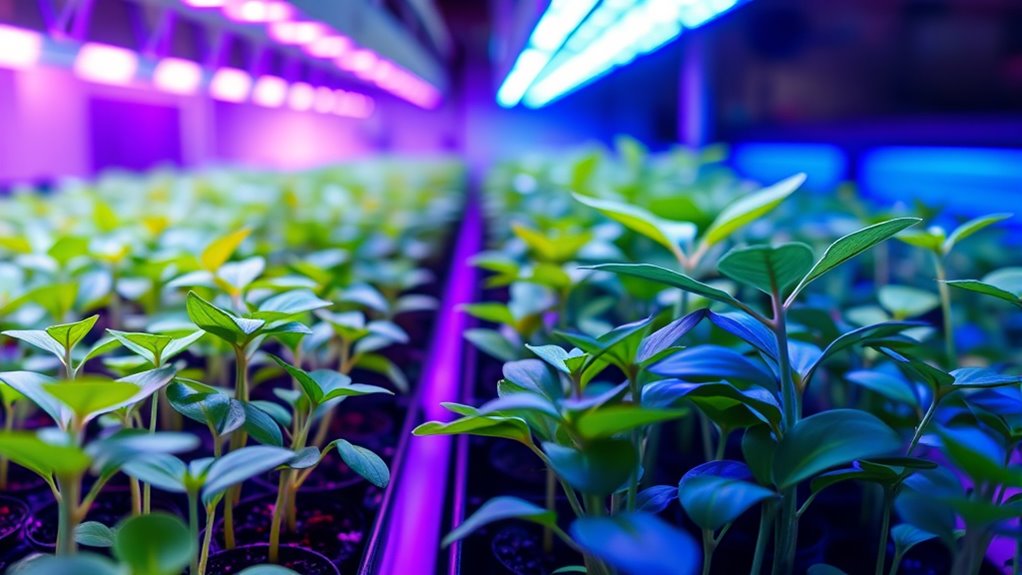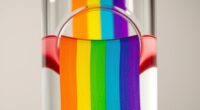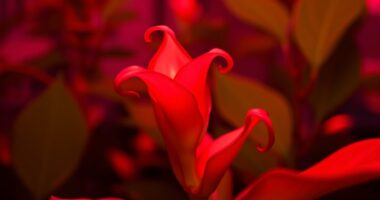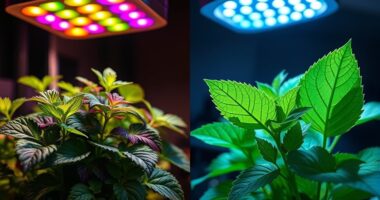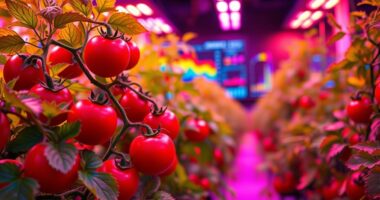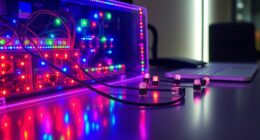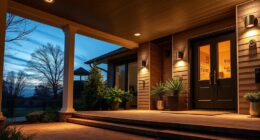When choosing between UV-A and UV-B for seedlings, aim for a higher UV-A to UV-B ratio to promote healthy growth without stress. UV-A penetrates deeper, boosting development, while UV-B triggers protective responses but can cause damage if overused. Use moderate levels of both and keep exposure times short, adjusting as needed based on your seedlings’ response. Keep an eye on stress signs, and you’ll set up the perfect lighting recipe—more details await if you keep going.
Key Takeaways
- UV-A promotes deeper tissue growth and enhances pigmentation, supporting overall seedling development with less stress.
- UV-B triggers protective compound production, increasing seedling resilience but can cause stress if overexposed.
- A balanced UV-A to UV-B ratio encourages healthy growth without damage; excessive UV-B may hinder development.
- Use moderate UV-A levels for growth signals and lower UV-B durations to stimulate stress defenses safely.
- Regularly monitor seedling responses and adjust UV exposure, distance, and duration to optimize lighting recipes.
Understanding the Differences Between UV-A and UV-B Light
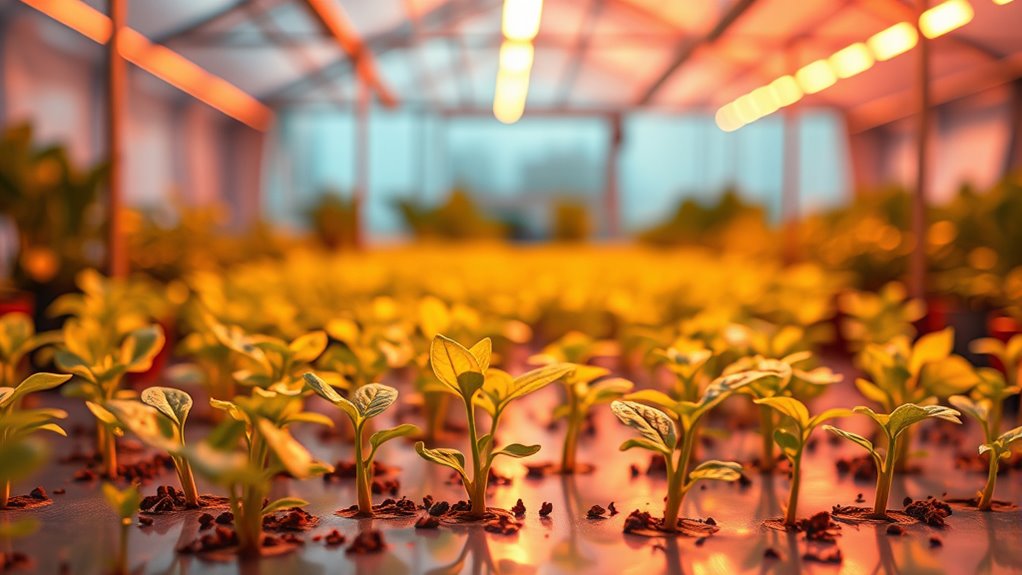
Although both UV-A and UV-B are types of ultraviolet light, they differ markedly in their energy levels and effects on seedlings. Both fall within the UV spectrum, which is part of the broader light spectrum that plants use for growth. UV-A has longer wavelengths, making it less energetic, and it penetrates deeper into the plant tissues. UV-B, with shorter wavelengths, is more energetic and can cause more noticeable effects on plant physiology. Understanding these differences helps you tailor lighting conditions for seedlings, as UV-A influences processes like pigmentation, while UV-B impacts protective mechanisms. Recognizing how UV spectrum components vary allows you to optimize lighting setups, ensuring your seedlings receive the right balance of UV light to promote healthy growth. UV spectrum components play a crucial role in shaping plant responses to light conditions.
How UV Light Affects Seedling Growth and Development
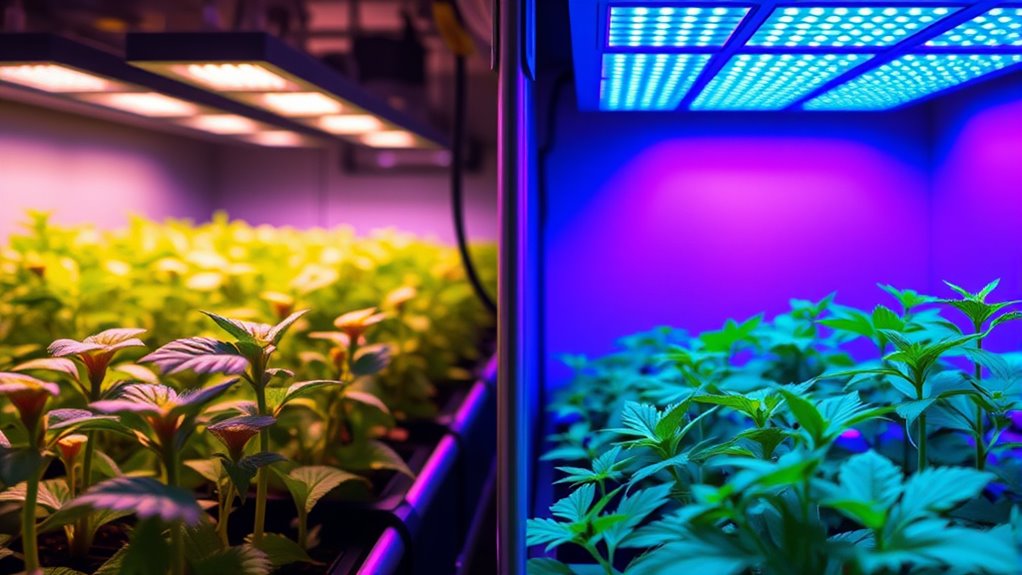
UV light plays a significant role in shaping seedling growth and development by influencing key physiological processes. Exposure to UV light spectrum stimulates protective responses and enhances nutrient uptake, leading to stronger, healthier seedlings. UV-A and UV-B rays trigger the production of secondary metabolites, which improve stress resilience and overall vigor. To understand how UV impacts seedlings, consider this table:
| Effect | UV Light Spectrum | Result |
|---|---|---|
| Stimulates nutrient uptake | UV-A and UV-B | More efficient absorption |
| Promotes protective compounds | UV-B | Increased resilience |
| Enhances growth signals | UV-A | Faster development |
Optimal UV-A and UV-B Ratios for Healthy Seedlings
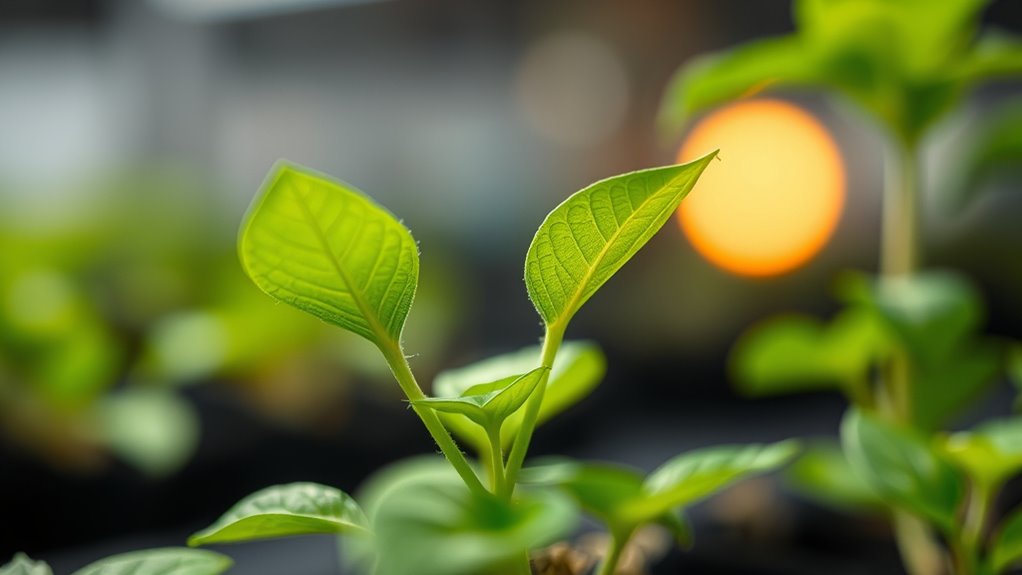
Finding the right balance between UV-A and UV-B exposure is crucial for promoting healthy seedling development. The UV light spectrum influences how plants activate specific plant photoreceptors that regulate growth and defense mechanisms. Typically, a higher ratio of UV-A to UV-B encourages robust development without causing stress, as UV-A penetrates deeper into tissues. UV-B, although essential in small amounts, can trigger protective responses if overexposed. Aim for a ratio that provides sufficient UV-B to stimulate beneficial responses without overwhelming your seedlings. Adjusting UV ratios based on the plant species and growth stage is key. Properly calibrated UV-A and UV-B levels help seedlings develop stronger roots, leaves, and overall vigor, setting a solid foundation for healthy growth. Understanding UV light effects can further optimize your lighting recipes for specific plant needs.
Crafting Effective Lighting Recipes for Seedling Success
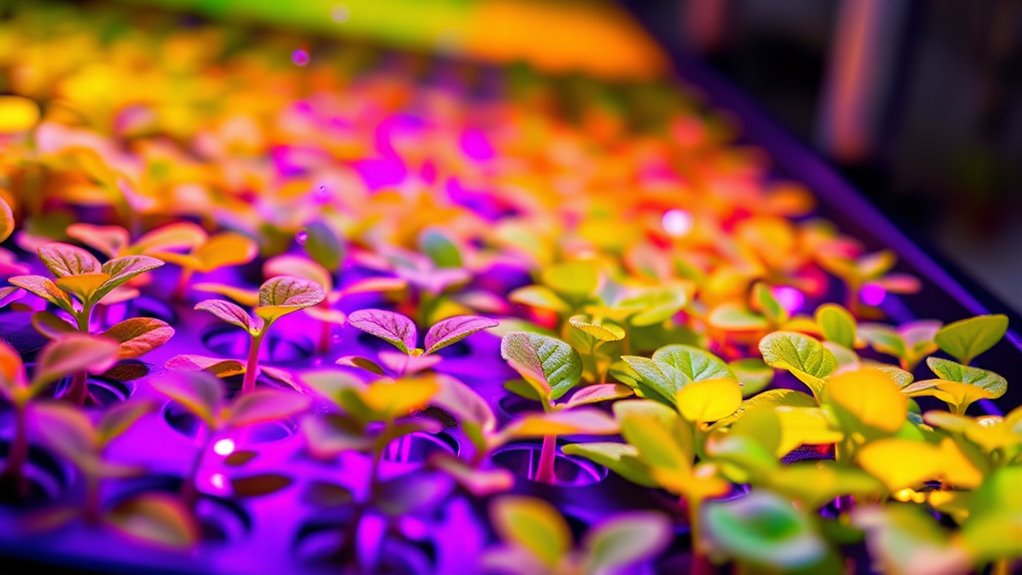
Creating effective lighting recipes for seedling success involves selecting the right combination of light intensity, spectrum, and duration to promote healthy growth. Incorporate the UV light spectrum thoughtfully to support development while minimizing seedling stress. Too much UV exposure can cause stress, leading to stunted growth or damage, so balance is key. Use a moderate intensity of UV-A and UV-B, adjusting based on the seedling’s response. Keep durations short, especially in the early stages, to prevent overstimulation. Combining UV light with visible light ensures proper photosynthesis and healthy development. Regularly monitor your seedlings for signs of stress or discomfort, and refine your lighting recipe accordingly. Proper plant care and management are essential for optimal growth. With careful calibration, your seedlings will thrive under a tailored UV lighting regimen.
Common Mistakes to Avoid When Using UV Light on Young Plants
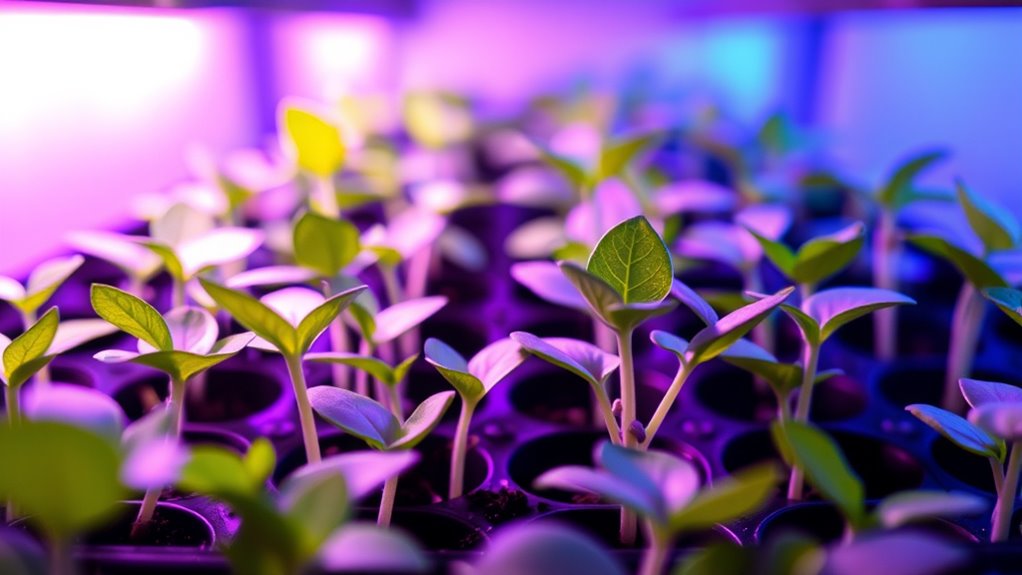
Avoid overexposing your seedlings, as too much UV light can cause stress or damage. Make sure you’re using the correct wavelength for their growth stage, since different types of UV affect plants differently. Always watch for signs of stress or poor health, and adjust your light setup accordingly. Incorporating UV Light Technology can improve growth results when used correctly.
Overexposing Seedlings Risks
While UV light is essential for healthy seedling development, overexposing young plants can cause significant damage. UV overexposure leads to seedling stress, weakening their immune systems and stunting growth. Too much UV can cause leaf burn, dehydration, or even tissue death, making seedlings appear scorched or deformed. It’s tempting to maximize UV exposure for faster results, but excess UV can backfire, impairing photosynthesis and overall vigor. To avoid these risks, monitor your seedlings closely and start with shorter exposure times. Gradually increase as they adapt, ensuring they receive enough light without suffering from stress. Remember, balance is key—too much UV can be just as harmful as too little. Properly managed, UV light supports healthy development without risking damage. Additionally, understanding the specific UV-A vs UV-B effects can help tailor your lighting recipe for optimal seedling growth.
Incorrect UV Wavelengths Used
Using the wrong UV wavelength can substantially hinder your seedlings’ growth, so it’s crucial to select the appropriate type. UV wavelength misconceptions often lead growers to assume all UV light is the same, but different wavelengths serve distinct purposes. For example, UV-B is more effective for stimulating certain plant responses, while UV-A influences others. Lighting spectrum errors occur when you choose a UV source with an incorrect wavelength, which can cause stress or minimal benefits. Using inappropriate UV wavelengths may also damage delicate seedlings or inhibit their development. To avoid these issues, understand the specific effects of each UV wavelength and match them to your plant’s needs. Proper knowledge ensures effective UV application, promoting healthy growth without unnecessary risks. Additionally, being aware of the types of cookies used on related platforms can help ensure your browsing experience remains secure and personalized as you research these lighting techniques.
Ignoring Plant Response Signs
Ignoring the signs your seedlings give off can lead to overexposure or underexposure to UV light, which may harm their development. When plants experience stress from excessive UV, they often show leaf discoloration, such as yellowing or browning, indicating damage. Conversely, insufficient light can cause weak growth and poor leaf health. It’s essential to monitor your seedlings closely and adjust UV intensity accordingly. Watch for signs of plant stress like wilting, leaf curling, or discoloration, and respond promptly. Regularly evaluating their response helps you find the right balance, preventing damage and promoting healthy growth. Remember, each species reacts differently, so tuning into your plants’ signals ensures you avoid common mistakes and support robust development. Incorporating auto functionality in some UV lighting setups can help maintain optimal exposure levels without constant manual adjustments.
Monitoring and Adjusting UV Light for Best Results
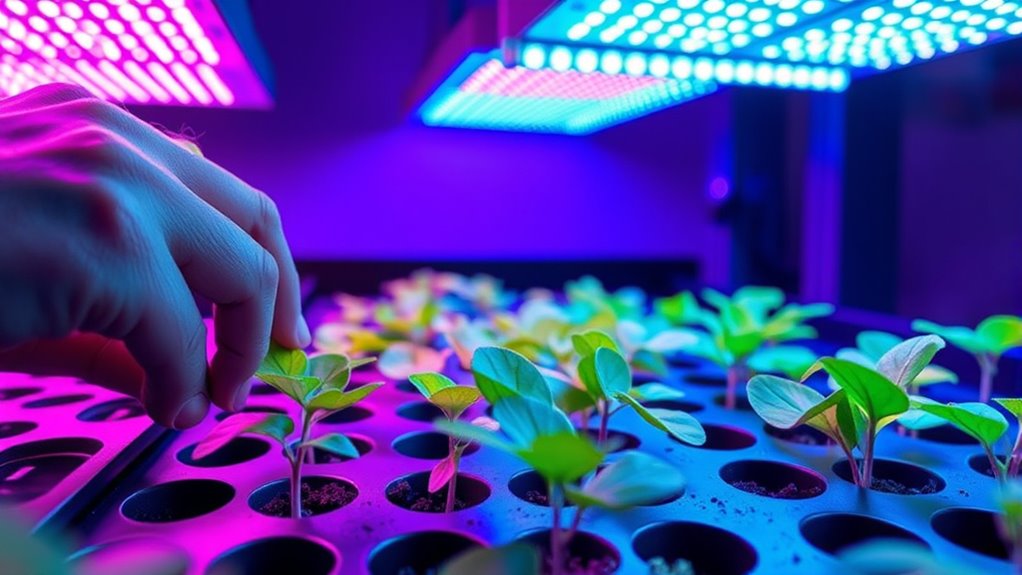
To achieve ideal seedling growth with UV light, you need to carefully monitor and adjust the light exposure regularly. Keep an eye on UV light intensity to prevent seedling stress, which can hinder development or cause damage. Use a light meter to measure UV levels and guarantee they stay within suitable ranges for your specific seedlings. If you notice signs of stress, such as wilting or discoloration, reduce the UV exposure immediately. Adjust the distance between your light source and seedlings or shorten exposure time to prevent overstimulation. Consistent monitoring allows you to fine-tune your lighting recipe, promoting healthy growth without risking damage. Incorporating proper lighting conditions is essential for optimal seedling development and ensures your plants thrive. Regular adjustments ensure your seedlings receive just the right amount of UV light for robust, vigorous development.
Frequently Asked Questions
Can UV Light Cause Seedling Stress or Damage?
UV light toxicity can cause stress or damage to your seedlings if exposed excessively, as their resilience is still developing. Too much UV, especially UV-B, can lead to leaf burn or slowed growth. To protect your seedlings, make certain they receive balanced lighting and avoid prolonged direct UV exposure. Properly managed, UV light can support healthy growth without harming your plants, but overexposure risks compromising seedling resilience.
How Do Different Seedling Species Respond to UV-A Versus UV-B?
Imagine each seedling as a unique musician, responding differently to UV light’s melody. Some species tune into UV-A’s gentle notes with ease, showcasing higher UV tolerance, while others may stumble under UV-B’s harsher beats, risking stress. Your role is to understand these species-specific responses, adjusting the light composition accordingly. By doing so, you foster healthy growth, ensuring each seedling performs harmoniously without undue stress or damage.
Is Natural Sunlight Sufficient, or Is Supplemental UV Lighting Necessary?
Natural sunlight provides a broad UV spectrum, supporting healthy plant development, but it might not always deliver consistent or sufficient UV levels, especially indoors or in cloudy conditions. If you’re aiming for ideal seedling growth, consider supplemental UV lighting to guarantee they get the right UV exposure. This helps promote stronger, more resilient plants by mimicking natural conditions and supporting their development beyond what sunlight alone can provide.
What Safety Precautions Should Be Taken When Using UV Lights Indoors?
If you’re using UV lights indoors, safety is vital—think of it as protecting your eyes from a laser show! Always wear UV protective goggles and keep the lights away from skin exposure. Make sure proper indoor precautions like ventilation and using timers to avoid overexposure. Follow UV light safety guidelines meticulously to prevent damage to your eyes and skin, making your indoor gardening safe and successful.
How Long Should Seedlings Be Exposed to UV Light Daily?
You should limit UV light duration for seedlings to prevent stress or damage. Typically, seedling exposure should be around 10 to 15 minutes per day, gradually increasing if needed. Keep a close eye on your plants for signs of stress, such as wilting or discoloration. Remember, too much UV light can harm your seedlings, so always start with short periods and adjust based on their response.
Conclusion
Mastering the balance between UV-A and UV-B light is vital for cultivating healthy, hearty seedlings. By blending beneficial rays with careful calibration, you can foster flourishing foliage and foster future foliage. Avoid accidental overexposure and always monitor your seedlings’ responses. With mindful measurement and moderate manipulation, you’ll master the magic of marvelous, resilient young plants. Embrace these expert tips to guarantee your seedlings thrive, transforming tiny sprouts into tenacious, thriving plants.
